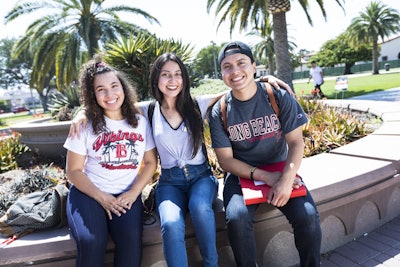Editor’s Note: Diverse: Issues In Higher Education and Excelencia in Education have partnered to exclusively release names of the institutions that have earned the 2020 Seal of Excelencia, a national certification that confirms an institution goes beyond enrollment to intentionally serve Latino students. The following school, Long Beach City College, is one of five institutions to earn the 2020 Seal of Excelencia. To learn more about the seal, visit https://www.edexcelencia.org/seal-excelencia-framework.
By developing programs specifically designed for Latinx students, Long Beach City College (LBCC), a two-year institution, has seen positive results.

Excelencia in Education CEO Deborah A. Santiago says she appreciates the institutional efforts of LBCC to link the students to the workforce as well as the sense of inclusion students receive. Rather than focusing on just enrolling students and letting them fend for themselves, LBCC — an open-access institution — has created a culture of inclusion and engagement, Santiago notes.
“They’re seeing that manifest in their retention and completion, and that stood out as super impressive,” says Santiago. “Their way of bringing students a sense of belonging and connection … through multiple practices.”
Earning the Seal of Excelencia provides validation for all who have committed to these intentional practices, says Muñoz. “You’re trying to help people understand that equity is not about sameness; it’s about targeting services and supports for our students who are most in need to eradicate the gaps that exist,” says Muñoz.
Targeted programming
“Students who have an educational plan are significantly more likely to actually enroll at the college than students who just apply or complete an orientation,” Muñoz says. “That educational plan is the tipping point. We deployed all of our counselors to our local high schools.”
Founded in 1927, today, LBCC is a minority-majority institution with approximately 86% of the students identifying as people of color. Of those, 57% are Latinx. It’s an Hispanic Serving Institution (HSI) and receives federal funding.
LBCC is the fourth largest community college of California’s 115 community colleges, with a student population of approximately 26,000 in the 2019-20 academic year. Of those, 18% are full-time and 82% part-time. Of the Latinx students enrolled during the 2019-20 school year, 56% were first-generation college students.
“Their students feel, ‘Somebody cares about me,’ even before they’re enrolled,” says Santiago. “Once students register, they continue that culture of caring and that sense of belonging. Community colleges don’t have lots of resources. We see a strong set of practices all the way through to completion and workforce.”
One significant program is the Long Beach College Promise partnership between LBCC, California State University, Long Beach (CSULB) and the Long Beach Unified School District (LBUSD). The Promise partners work together to help students transition between institutions. This includes a tuition-free first year at LBCC.
Follow through
After a zip code analysis, two high schools with the highest percentage of Latinx and African American students were identified. Each week, LBCC staff spend time at these schools. Students can learn more about their educational options, financial aid and the application process. They’re also assisted in creating an educational plan in which students outline the courses they will take in order to achieve their educational goals. 
Muñoz worked with the principals and they agreed to have every senior apply to LBCC, thus all students prepare an application. LBCC has seen a 36% increase in Latinx enrollment overall and a 42% increase at prioritized high schools.
Some of the support services for Latinx students at LBCC include parent engagement. Muñoz says the turnout for family nights has been very strong.
Faculty have engaged in a cultural curriculum audit. More than 150 faculty members have thus far gone through their course outlines and syllabi to identify opportunities to enhance the curriculum and make it more inclusive.
LBCC also implemented completion counselors. Using data, students in need of high-touch practices are identified for intrusive advising. Muñoz says, instead of waiting for students to ask for help, counselors proactively reach out to students close to graduation and make sure they are aware of any courses they need or actions they should take to reach completion.
Faculty and staff have gone through University of Southern California (USC) Center for Race and Equity training. Campus leadership worked on building its racial literacy and how to engage in diversity and inclusion on campus. Also, LBCC’s human resources department has partnered with USC’s Center for Urban Education for training on hiring practices.
When Muñoz came to LBCC in 2018, he saw the college was returning close to $200,000 a year in unspent federal work-study funds. He implemented an equity-conscious, work-study redesign in which male students of color were targeted.
“Obviously, this year is different because of COVID,” says Muñoz. “We don’t have a full work-study program. But last year, I’m very proud to say we didn’t return any money.
“One of the other things that we did with our federal work-study is creating these peer navigator programs so students can assist other students,” he continues. “They’re affiliated with programs on campus like Justice Scholars, which works with formerly incarcerated students or students impacted by the system. … We’ve been strategic to use these work-study programs to help support those students.”
Impact
Muñoz says there is a consciousness of the need for increased representation among faculty, staff and administration, and there is a Latinx faculty and staff association. The college supports professional development.
LBCC also has DESTINO, a Title V funded program designed to support Latinx students in the STEM disciplines. A dedicated STEM counselor/academic advisor works with DESTINO students to make sure they’re on track to transfer to a four-year institution. These students also have access to student success coaches, who help them navigate the transfer process and stay on track with their long-term goals.
“We’re redefining that pathway and making it race conscious,” says Muñoz. “Our counseling and advisement, we’ve moved to a case management model in a lot of ways, using the data to identify cohorts of students that we case manage.”
Moving to this model has increased degree completion and transfers for both Latinx and African American students.
“When we have a race conscious, intentional strategy, we see these successes and gains, and we see the closing of some of these disparities that we’ve had at the college,” says Muñoz.
The transfer center helps arrange trips to four-year institutions as well as trips to see STEM-focused employers with the purpose of cultivating a sense of belonging in those spaces.
In 2018, LBCC launched the Dream Center, which advocates for undocumented students through all phases of their association with the college. Approximately 80% of the students utilizing it identify as Latinx. Since its inception, the transfer rate for these students has increased by 71%. The Dream Center recently established a partnership with the Coalition for Humane Immigrant Rights of Los Angeles (CHIRLA), which provides free legal consultations on immigration issues to LBCC students and their families.
As the COVID-19 pandemic unfolded, LBCC quickly implemented an emergency student aid application that is embedded within the online student portal. Students can request food, computers and hotspots. There is a weekly grocery distribution as well as free gift cards to grocery stores for students who cannot make it to campus for the grocery distribution. The college has increased the number of hours its mental health providers are available for virtual services. Muñoz forged a partnership with local hotels to house students experiencing homelessness due to the pandemic.
“We’ve been very comprehensive with our case management and aligning services,” Muñoz says.
Muñoz sees the Seal of Excelencia as a call to action to advance the work. He hopes it leads to more opportunities to accelerate the work around access, success and completion.
“Now that we have this distinction, for me it’s ‘game on,’” he says. “This is a very unique time in our country’s history. There’s a lot of civil and racial unrest. This also helps us be really declarative that … we’re going to talk specifically about different groups of students.
“We use data,” he adds. “We know how many Latino students and Black students we need to graduate to close these [achievement] gaps.”
This article originally appeared in the October 1, 2020 edition of Diverse. You can find it here.





















